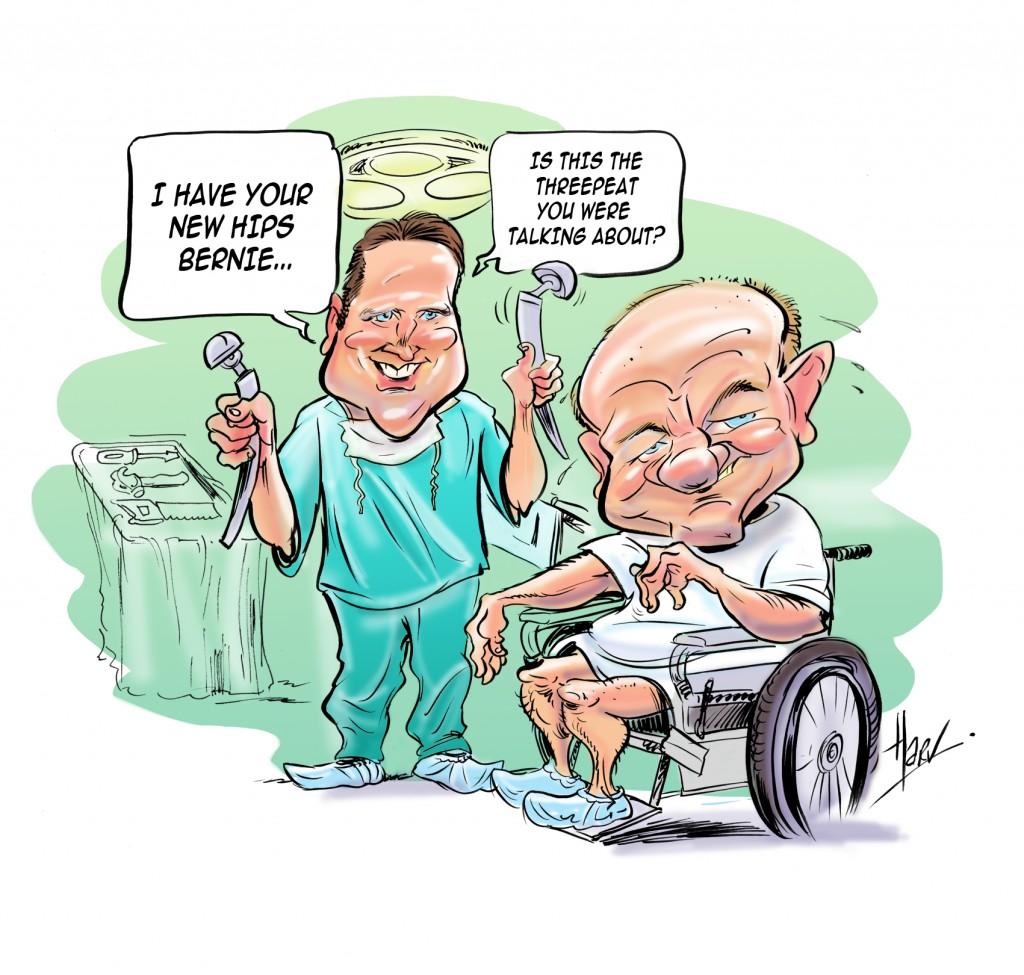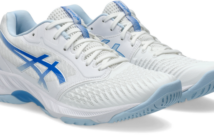Dr Bernie Crimmins sheds some light on the bone jarring issue of arthritis.
Bob came into my room gingerly.
“It’s me Arthur-itis Doc. I’m stiffer than a rabbit on Viagra.”
I told him that it is truly a fact that as we get older, the things you want to get stiff don’t and the parts of your body you don’t want to get stiff, do. The X-rays that he carried in with him showed his lower back to be worn, as well as both of his hips. I had sympathy and empathy as only 6 months prior I had gone through a total hip joint replacement.
My worn hips were a legacy of many hours at the cricket bowling crease where I bowled myriad overs of right arm medium crap, I mean pace. My left leg pounded into the pitch then my whole body would swivel on it, grinding the head of my thigh bone into the socket in the pelvis. I was unaware that I had a fairly common genetic problem in both hips called a cam lesion in which the head of my thigh bone was misshapen and hence could not fit properly into the socket. Over time the cartilage rim around my hip wore away and then the joint narrowed down as the normally smooth and glistening articular cartilage broke down and wore away.
I developed severe osteoarthritis of the hip with progressive restriction of movement with stiffness, pain and a limp. I put up with it for about 12 years before eventually deciding it was time to have the replacement done. I was still managing to have a game of footy which I loved and knew that would be over once I had the hip replacement. With contact sport, I could easily dislocate the new hip and Cameron. My terrific Orthopaedic Surgeon would be pretty upset that all his wonderful handiwork had been undone. I have fortunately been able to go back to jogging around and having a kick at footy training though, which I am really pleased to be able to do. I need the camaraderie of my Bald Eagle footy mates.
Arthritis and its causes
Arthritis occurs when there is inflammation and degeneration in a joint. A joint is a join between two bones. There is generally cartilage on the ends of the bones which is smooth and lubricated to help the bones glide over one another. This wears away and eventually bone grates with bone. There are over 300 joints in the human body but I see most arthritis occurring in the spine, hips, knees, ankles, shoulders, elbows and the small joints of the hands and feet. Most is what we term Osteoarthritis which is basically due to excessive wear and tear or overuse of a joint.
An injury early on in life may set you up later in life to develop arthritis in the damaged joint. This may be a severe soft tissue injury such as whiplash to the neck or a severe ligament injury like a cruciate or collateral ligament tear in the knee or a severe ankle sprain. Shoulder dislocations can also set up the environment for an arthritic shoulder down the track. I suffered a severe ankle fracture from football when I was only 19 and this has left me with a “frozen” ankle which is arthritic. It doesn’t give me much pain but it did alter the way I walked so it probably contributed to the arthritis developing in my left hip.
You can develop arthritis in joints for reasons other than injury or biomechanical issues. It can be caused by auto-immune processes which are still not fully understood. These are the Rheumatic group of conditions of which there are plenty. The commonest is probably Rheumatoid arthritis itself. It is thought that something comes into the body, like a virus, and the body produces antibodies to attack and destroy the intruder, which it does. Unfortunately in some, the virus or whatever the agent is, has similar characteristics to the normal tissue within and near your joints such as cartilage and ligaments. Thus the body’s immune system sees this normal joint tissue as being abnormal and starts attacking it and breaking it down, leading to the arthritic process.
Osteoarthritis tends to kick in along with the ageing process and affects you more as you get older but the Rheumatic conditions can occur at any age (even in children). Apart from the slowly developing arthritic conditions, there are the sudden or acute versions of arthritis too. The type I come across most often is gout. In this condition, crystals of uric acid suddenly develop within the joint, classically the big toe, and the joint becomes red, hot, swollen and very, very painful. I have seen it develop in other joints such as the ankle, knee and wrist. Another very serious cause of an acutely inflamed arthritic joint is infection or septic arthritis. You should see your GP as soon as possible if a joint suddenly becomes painful as certain tests need to be done and treatment started pronto.
Symptoms
The main symptoms include pain, stiffness and reduced mobility due to a limitation of the range of movement of the affected joint. The initial pain is not too bad and tends to come and go. You have your good days and your bad days. It may be influenced by the weather, being more severe in the colder weather, which explains the annual migration of the Victorian elders to sunny Queensland in the winter. It tends to get worse as the day goes on and is not too bad in the morning. But this is the time that stiffness is the worst.
I remember having great difficulty pulling my socks on in the morning. I would say that was the first symptom that alerted me to my shonky hip. The limitation of movement progresses and restricts your capacity to do certain tasks depending on the joint affected. I developed a progressive limp which I wasn’t aware of but did get annoyed when people kept asking me why I was limping. “I’m not limping, damn it,” was my typical response. I actually was.
With some of the Rheumatic arthritic conditions there may be other symptoms such as eye complaints and even rashes that may occur. This requires a bit of detective work by your GP.
Signs of an arthritic joint
I was always taught to assess this by: Look, Feel and Move. When you look at an arthritic joint it can appear completely normal. However it may be quite knobbly and swollen compared to the other side. It may be slightly warmer to touch and be a bit puffy and soft too. When the joint is moved with your hand on it you may feel a grating sensation that doctors call crepitus. It is felt commonly in the knee when the knee cap joint starts to wear down. When the joint is moved and compared to the other side there is a restriction in certain movement directions.
Tests
An x-ray is generally required as a base-line. Often people come in wanting some form of a scan but you must always start at the beginning. A plain x-ray can give sufficient information to make a diagnosis. Blood tests may need to be performed if your doctor is suspicious that it might be something other than osteoarthritis. Sometimes scans such as CT or MRI may need to be ordered. The important thing is to get a diagnosis!
Treatments
For the chronic, on-going, degenerative osteoarthritic conditions, there is generally nothing that will turn back time and make your joint new again. It is mainly about controlling pain and maintaining mobility so that you are still enjoying life. Eventually the joint may need to be replaced but the material used in the joint replacement has a limited lifespan so it is put off within reason; weighing up symptoms versus the age of the patient. Initially my pain and joint immobility were not too severe and I was too young to have the hip replacement as it could have meant I’d need a second or even third down the track.
Lifestyle issues are always important to address. If you are overweight, make a concerted effort to get the weight off, particularly if a joint replacement may be contemplated in the future. People often ask me if there is a specific anti-arthritic diet that they can follow. There isn’t, and those that are recommended often come in with the standard myths of avoiding tomatoes and dairy products. I suggest a healthy diet that controls your weight with plenty of plant based foods, fish, meat and dairy products but with the portion control linked in with your exercise capacity which may be limited due to your arthritis.
Exercise is important to control your weight and maintain the range of mobility in the affected joint. When my hip started to play up and it was limiting my walking and jogging, I cranked up my swimming to the point that I was probably swimming some 10km per week. Physical therapies such as physiotherapy can be useful. Some get assistance with other allied health professionals such as osteopaths, chiropractors, therapists and masseurs but I will get myself into trouble if I try to extoll the virtues of one over the other. If it helps, keep doing it and if it doesn’t help then don’t waste your money.
Potions and lotions
A lot of people start off on something because someone they know took it and it helped them. I am very sceptical about a lot of potions and lotions and if they’re very expensive, I’m even more sceptical. Glucosamine is a prime example. There is some modest research evidence to suggest it may have some use in knee arthritis. This was then expanded by the supplemental pharmaceutical industry to cover arthritis in general. A huge and vulnerable patient base was targeted. It helps some but it is very expensive. Try it if you wish but if it doesn’t help, don’t keep taking it. I am a bit more convinced about fish oil as even if it doesn’t help the arthritis it has other benefits such as improving your cardiovascular system. A lot of the rub in gels and liniments may have some benefit but I think it is more the fact that self-massage is applied to get them in.
The drugs
Plain old Paracetamol is probably the safest for long term pain relief although you need to keep an eye on your liver. It can be taken on an as-required basis or on a regular 3-4 times a day dosage regime. The group of drugs called NSAIDS or non-steroidal anti-inflammatory drugs have been the mainstay of most arthritic treatments for a long time. Their long term use has been reined in a bit because of concerns with their side-effects. They are derivatives of Aspirin and can upset the stomach of some, causing ulcers and gastritis.
The kidneys need to be assessed and a couple had to be taken off the market because of concerns about their association with heart disease as they can also cause high blood pressure due to fluid accumulation. If they are taken with food and for short periods of time, such as a few days to a week, then they can be quite useful. I have patients who will take them only on their golf day and I couldn’t have completed the Kokoda Track without them. They enabled me some time before having to get my hip replaced and it was the fact that they eventually stopped working that led me to make my decision about getting the operation done.
Steroids or cortisone is used and very useful for acute flare-ups but can’t be used long term because of side-effects. In the form of injections into the arthritic joint it can be useful in biding some time before the inevitable has to be done. And I have a confession to make. I had one into my hip joint to enable me to play my last game of AFL prior to getting my footy career ending surgery. I felt like a new person but paid for my sins a few days after the game.
I flew through the hip joint replacement surgery which is some six months ago now. Here are some tips:
Make sure your surgeon or your GP arranges a thorough medical check-up before having the surgery. My surgeon, Cameron works in tandem with a general and post-operative Physician, Dr Con who went over me with a fine tooth comb before giving the go ahead for the surgery. If anything went wrong medically then he could jump in and look after the problem straight away as he already knew me well.
If you are overweight, get the weight off. You will recover better.
Do the pre-habilitation: that is the new name for getting yourself fit beforehand and savvy with all the things such as the exercises that you will need to do post operatively. Practice them so that you can get into them as soon as possible after the surgery.
Don’t overdo the pain killers post operatively as they will just zonk you out, causing you to waste valuable post-operative exercise time.
I looked at Bob. He was way overweight, on lots of different medications for high blood pressure and diabetes, as well as an ex-heavy smoker. If surgery was going to be the inevitable solution then we had a lot of work to do. Hopefully we can get him through it and happily setting off the metal detectors on his next plane flight. I haven’t had that experience yet!
As always, stay happy and healthy… And I won’t mention the Three-peat.
Go Hawks, Bernie/Buna.





